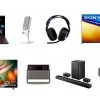Reprinted with permission from Knowledge@Wharton.
What’s in a Name? For Apple, a Focus on the Digital Living Room
Apple’s name change from Apple Computer to Apple on January 9 highlights the company’s new reality: CEO Steve Jobs’ strategy today revolves around converged consumer devices much more than around personal computers.
Indeed, Apple’s recent announcements point to a consumer electronics company more than a computer maker. On the same day it announced its name change, the company launched the iPhone, a cell phone-iPod hybrid, along with Apple TV, a device to deliver video content downloaded through Apple’s iTunes service to consumers’ television sets. On January 17, Apple stated that it had sold 21 million iPods in its fiscal first quarter ending December 30. For Apple, the iPod and iTunes businesses represented $4 billion of the company’s total $7.1 billion in revenues for the same quarter. Sales of Apple’s Mac computers, in contrast, accounted for $2.4 billion in revenue. Apple shipped 1.6 million Macs in the quarter, below the 1.75 million Wall Street some analysts were expecting.
Experts at Wharton note that Apple’s new moniker makes official a business strategy that has been underway since the iPod was launched in 2001. That strategy: Create devices that will form the hub of the digital living room, where audio and visual content will be available on demand and can be networked seamlessly across multiple devices. But just as it did in the PC industry, Apple faces tough competition. The same week that Apple introduced its iPhone, Microsoft — which also has designs on the digital home — unveiled the Home Server, a device that will back up digital content throughout one’s house. Apple also faces other rivals such as Sony, which has delivered living room electronics for years.
Meanwhile, Apple has to walk a fine line between locking customers into its platform to boost profits while also making sure that its products work easily with other electronic devices.
Wharton management professor Sarah Kaplan suggests that Apple’s name change doesn’t have any direct impact on the business, but does accomplish the following: It signals to employees the company’s long-term strategy, it clarifies the marketing message and it prods investors to compare Apple to consumer electronics firms rather than just computer makers. In addition, says Kaplan, “consumer electronics has always valued design, and that’s what Apple’s strength is.”
But to Wharton marketing professor Peter Fader, Apple’s name change is the equivalent of waving a white flag in the PC market. “How many Apple computers has the iPod sold?” asks Fader, alluding to the so-called “halo effect” where consumers who buy iPods may tend to migrate to Apple’s computers. “The reality is that Apple is still a small part of the PC industry. The name change is recognition that it has lost the PC market.”
Others say Apple’s convergence strategy is blazing a new growth path as the PC market becomes commoditized. Eric Clemons, Wharton operations and information management professor, says the convergence of the PC, home entertainment equipment and wireless devices dictates that Apple gadgets such as the iPhone and iPod will be increasingly important. “Apple brings several things [to the market]: really sleek cool hardware, great software and a cool hip image,” says Clemons. The company, he adds, “is trying to integrate a personal entertainment system [the iPod] and a personal online music store [iTunes] with more family-centric home stereo and home video.”
And if Apple is successful — Apple CFO Peter Oppenheimer noted on January 17 that the iPod controlled 72% of the digital music player market at the end of December — it could have the last laugh over Microsoft. “As the convergence of PCs and consumer electronics moves ahead, you have a lot of complexity,” says Kaplan. “And it’s unclear if Microsoft can dominate. If Apple wins as markets converge, even if it has lost in the PC market, it will ultimately have the last laugh.”
Old, and New, Kids on the Block
According to Fader, it’s far too early to predict whether Apple will get the last laugh on Microsoft. After all, Apple is playing in a new neighborhood when it comes to digital convergence. Microsoft is a familiar foe and competes with Apple in operating systems, music players and digital entertainment hubs. But other competitors are new. For example, with the launch of the iPhone, Apple takes on the likes of Motorola, Samsung, Nokia and Research in Motion, to name a few. In addition, Apple doesn’t have a wide range of businesses to combat a company like Sony on all fronts. “Apple isn’t a Sony,” Fader says. “It’s picking its niches and going deep in them.”
In addition, Apple could run into problems with the convergence concept behind its iPhone. The iPhone could take away sales of the iPod and still not be able to compete against Research in Motion’s Blackberry and Palm’s Treo, says Fader, adding that “for cell phones, functionality wins over design.”
Fader also suggests that the Apple TV device is no slam dunk. It’s unclear, for example, whether consumers want to beam Internet-downloaded video to televisions, or whether the picture quality will be adequate on a big screen. “If you asked me five years ago whether the digital living room would be here by 2007, I would have said ‘yes,'” says Fader. “But it’s not clear whether the market place wants [the convergence]. Consumers seem intent on having the TV on while messing around with their laptops on the couch.”
Clemons isn’t as pessimistic, predicting that Apple can more than hold its own against rivals such as Sony. Clemons, in fact, argues that Apple has Sony outflanked in many key areas. “Sony seems to have lost its way. It has great technology capability, but it doesn’t have buzz anymore. Little white earbud headphones [synonymous with the iPod] were called ‘mug-me-whites’ because they were usually connected to a theft-worthy iPod. It has been a long time since Sony has had the buzz that Apple has.” In addition, it’s not clear that Sony’s strategy to control the digital living room with the Sony PlayStation 3 is going to work. “The integrating factor [for the PC and consumer electronics] is going to be either a computer or a cell phone, not a TV or [game station]. Sony lacks presence in either. Apple now has both.”
Kendall Whitehouse, senior director of information technology at Wharton, adds that Microsoft also remains a formidable rival. Even though Microsoft’s Zune music player didn’t debut to the critical acclaim afforded to the iPod, Microsoft has the resources to keep developing the product. In addition, Microsoft’s Xbox game machine can also serve as a media hub for sending video from Microsoft’s Media Center Edition PCs to consumers’ large-screen televisions.
Meanwhile, adds Kaplan, it’s becoming increasingly difficult to categorize Apple’s competition. Like Microsoft, Apple’s competition will have to be ranked by product line and the company may wind up eventually competing across multiple niches. “Apple has become much more diversified, so you don’t compare it by peer group as much as by product line,” says Kaplan. “For instance, the iPhone competes with Motorola and Nokia. For PCs, it’s Dell. Like General Electric, you break the company down by product line. The products are remarkably distinct.”
Apple’s Assets
In the new competitive landscape, Wharton experts agree that Apple has a bevy of core assets to fend off its foes, with design prowess as its primary edge. It also has a keen eye for making complicated technology — such as digital rights management software that restricts how content is played and shared — simple enough for consumers to use.
Design, however, goes beyond developing cool gadgets, says Wharton business and public policy professor Betsey Stevenson, who has studied how consumers adopt new technology. According to Stevenson, technology that’s consumer friendly speeds adoption of advanced technologies. “Think about the introduction of ATM machines,” she says. “This technological change was difficult for most people at one time, but it now seems trivial.”
As Knowledge@Wharton previously discussed, the digital living room still faces a number of hurdles. Yet many of these — such as networking multiple entertainment devices — can be overcome with good design. Stevenson says consumers build their technology knowledge with each new device. For instance, the ATM machine paved the way for consumers to use kiosks for other items such as airline tickets. However, good design can dramatically speed up adoption rates because consumers “don’t need to build their stock of technology knowledge to find them easy to use,” says Stevenson.
Given the importance of design, Apple may have a good shot at becoming the technology leader of the digital living room. Clemons says that Apple’s design skills also go beyond new gadgets to encompass software design. One of Apple’s real design feats was making it easy for consumers to buy music legally without excessive digital rights management [DRM] software. “Apple’s iPod and iTunes store are quite tightly coordinated to make theft of content or illicit transfer of content cumbersome,” says Clemons. “It’s surprisingly easy for consumers to forget why there are restrictions and where the restrictions come from.”
Aside from Apple’s design edge with the various flavors of the iPod and new gadgets such as the Apple TV and iPhone, the company also has an often underestimated asset — its loyal customer base, says Kaplan. In consumer electronics, the key to success is perfecting a product rapidly, she adds, and that rapid development isn’t easy when a company has to worry about where it will get its first million customers. Apple has no such worry: Its first million units of any new product are nearly guaranteed to be gobbled up by rabid fans.
That loyal customer base gives Apple a rapid learning curve that few companies can match. For instance, the iPhone is expected to debut in June amid high demand. That demand will enable Apple to gain user feedback and refine the product rapidly. Ultimately, this process leads to mass adoption. “There is this die-hard group of people who will buy anything that’s new from Apple,” says Kaplan. “When you are not worried about where your first million customers are going to come from, you can move down the learning curve fast. And once you move down that curve, you can get the product that customers want and anyone can operate.”
The Vertical Integration Game
So what could trip Apple up? Wharton experts say consumers could eventually chafe at Apple’s attempts to vertically integrate its products — and thereby lock customers in — instead of working with other devices. Vertical integration refers to efforts to own multiple parts of a product chain. For instance, Apple operates its iTunes music sales channel, controls the digital rights management software and sells the devices to play content. As a previous Knowledge @ Wharton article reported, Microsoft is following a similar vertical integration strategy with Zune and other products connected to its Windows platform.
However, it’s unclear whether this vertical strategy will ultimately win out with consumers, who may demand support for multiple standards. As it stands now, Apple has its digital rights management software and Microsoft has its own DRM scheme and neither is compatible with the other. That means libraries between the two platforms can’t be easily shared. “As long as Microsoft and Apple have different digital rights management systems, they probably cannot seamlessly transfer content from one device to another,” says Clemons.
Whitehouse suggests that the tension between a technology integration strategy (typified by Apple’s iPod/iTunes juggernaut and Microsoft’s Windows platform), and creating standalone “plug and play” consumer electronics, will exist for a while. Apple’s recent announcements, he notes, embody this tension between working with all devices and trying to lock customers in.
He points to Jobs’ Macworld speech on January 9, during which he unveiled the Apple TV and said: “Apple TV is a way to enjoy your digital media on your big-screen TV. You can buy great content on the iTunes music store. Now you can go out and buy a wide-screen TV, hook up an Apple TV to it and wirelessly transmit content. It’s as simple as that.” Jobs’ speech was telling, Whitehouse suggests, in the way he walked a fine line between touting the number of ports on the Apple TV device, which matters to the techie crowd, and noting that the device is easy to use, which appeals to consumers.
Apple appears to be following a hybrid vertical integration strategy, Whitehouse adds, noting that Apple is focusing on iTunes as the single hub for digital content, yet delivering a system that works with both Macs and Windows PCs.”Since Apple has a smaller market share in operating systems, it had to think about working with other systems. For instance, iTunes and the iPod work on both Windows and the Mac.”
However, as Fader points out, Apple isn’t taking the next step, which is allowing multiple DRM formats on iTunes. Fader argues that Apple has taken half measures when opening up its software to more platforms because it wants to lock in customers on iTunes. “iTunes and iPod are a contradiction. Apple opened them up to Windows, but why don’t they go one step further?” he asks.
According to Kaplan, these issues — platform wars, vertical integration efforts and multiple players — are often the norm in immature markets. Any television can work with any DVD player, she notes, because standards were agreed on by electronics manufacturers as the market matured. But, as described in Knowledge @ Wharton’s recent coverage of the current format war in high-definition DVDs, consumer electronics aren’t always interoperable when technologies are new.
Indeed, Fader doesn’t expect the digital living room to see format harmony for a while. Microsoft will try to run digital entertainment with Windows, Apple will push iTunes and Sony is looking toward its PlayStation 3 as its secret weapon.
The bottom line, experts at Wharton note, is it’s still early in the development of the digital living room, and that means more strategic trials and errors lie ahead.
Reprinted with permission from Knowledge@Wharton, the online research and business analysis journal of the Wharton School of the University of Pennsylvania.“






























